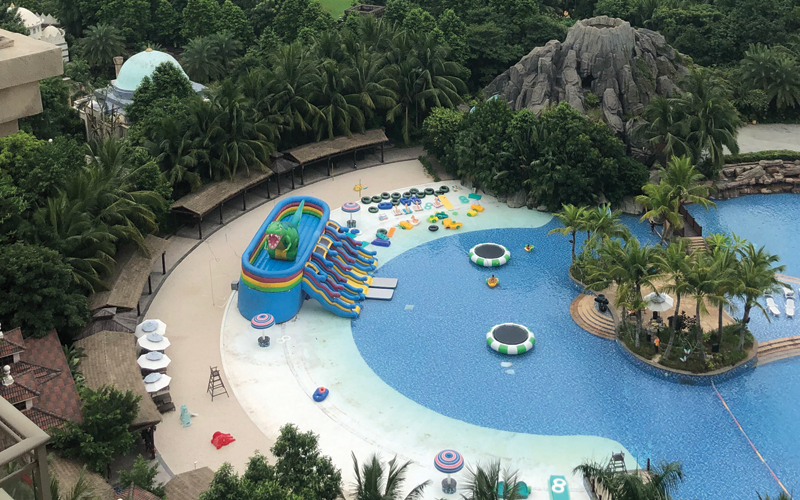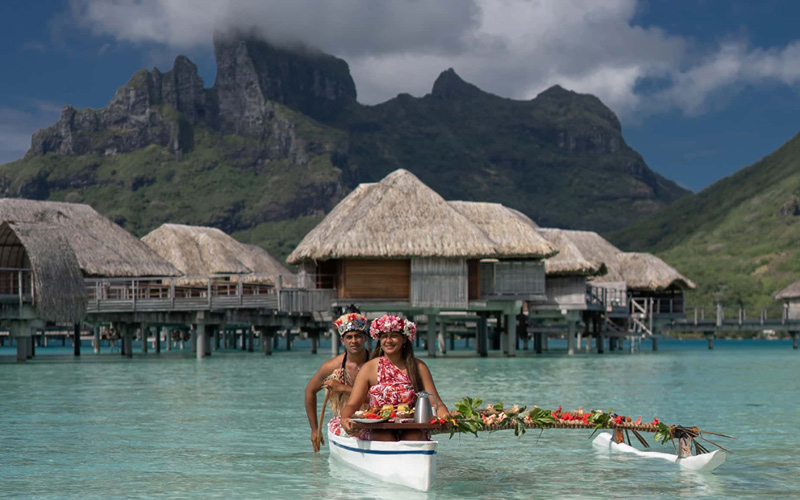Charms of Asia
Resorts rich with hot springs and golf courses may not be the first picture that comes to mind

when you think of China, but it should be, if Hainan Island is on your travel itinerary. Similarly, you may think first of wonders like the Great Wall and bustling cities, but the panda wildlife sanctuary in Chengdu, in China’s Sichuan province, is a stand-out attraction, alongside the region’s mouthwatering-and mouth-testing-spicy cuisine. JAX FAX experienced both of these high points of China during a journey there in October, which started in the tropical resort playground of Haikou on Hainan Island to attend the World Tourism Exchange conference, and ended alongside panda bears and savory spices in Chengdu.
Volcanic Craters-and Golf
Even on a fall morning, a day in Haikou often begins with abundant warmth and sunshine-and hot springs. At the Marriott Haikou, where JAX FAX stayed, guests could alternate between lounging in hot-spring tubs and cooling off in the hotel’s nearby pools, one of which was a river pool.
The relaxation at a Haikou resort makes a nice counterbalance to the brisk exercise visitors can experience at Leiqiong UNESCO Global Geopark. Perfect for both casual strolling and hiking, the site includes an outdoor Buddhist temple, which can be easily reached via the “Volcano Goddess Track,” and the opportunity to hike along the caldera of a volcanic crater. The dense trees, tropical greenery and sometimes challenging hiking, bring you deep into nature. The reward you get after a brief climb of the view to the bottom of the crater makes the hike well worth it. Those looking for a more intense hiking experience can descend a staircase into the crater.
The reputation of Haikou as a place to come to unwind and exercise is getting a boost with the growth of golf in the area. The Haikou Mission Hills International Golf Resort offers more than half a dozen courses, including the World Cup Course, which was named “one of the ten most significant and influential courses of the last 20 years” by the golf publication LINKS. A golf enthusiast could easily spend days exploring this one resort area’s courses, while taking breaks to enjoy the more than 100 hot-spring pools on the property, many of which are labeled for their medicinal value. You might come across a hot-spring tub labeled, “Ginseng Spring,” touting benefits for the nervous system, “tranquilization” and “disease resistance,” or one labeled “Lingzhi Spring,” noting its value in aiding immunity, metabolism and anti-aging.
Cultural Exploration
You can take a break from the sun at Hainan Museum. Covering an area of 40,000 square meters, the museum displays cultural relics and specimens related to the history of the South China Sea and its surrounding areas. You can see bamboo hats worn through the centuries, learn about the ancient paper-cutting art and see traditional bamboo and wooden musical instruments. In addition, you can get a sense of the evolution of the area through the traditional tools on display, and exhibits that explore how natural resources, like fragrant rosewood, were used.
A stroll down Arcade Street in Haikou also can give you a sense of the local culture. On one block, large pastel umbrellas are framed against striking white building facades. You might end up in a shop that sells local teas and coffees, and offers samples of blends like coconut ginger tea.
Just as important as what you see and do in Haikou is the food. To a Westerner, the food will be an adventure, and unlike the Chinese cuisine common in the U.S. and Europe. One dinner included “abalone special glutinous rice wine, Jiaji duck jelly, Hainan square beans, poached Wenchang chicken and Dongshan baby lamb”-and those were just the appetizers. Another meal included “cucumber/crispy jellyfish, vegetable salad and black fungus with wasabi.” Other memorable offerings included “stir-fried celery mix seafood ribbon with ox sauce,” “stir-fried cashew nuts mix mussels” “barbecued goose Hainan style” and a dessert of “taro mix with coconut milk.”
Pandas & Palate-Pleasers
From Haikou on Hainan Island, our travel group journeyed to Chengdu in the Sichuan province on the Chinese mainland. This is a large area, both geographically and in population, spanning 14,000 square kilometers and home to 17 million people, who are proud of maintaining a relaxed attitude. That laid-back approach to life is evident at People’s Park, where locals sing, dance, exercise, drink tea and play mahjong at century-old teahouses. This was the first stop after landing in Chengdu, and it set the stage for days ahead that would be punctuated by the province’s particular take on life.
Perhaps the most valued resident of Chengdu is its panda bear, which you can see in an enclosed wildlife preserve at the Chengdu Research Base of Giant Panda Breeding. The grounds allow visitors to see pandas as they live in nature, high in trees amid a forest dense with their primary sustenance, bamboo. They are amazingly nimble for large creatures, climbing to treetops with as much agility as housecats, so that you sometimes have to keep your eyes peeled for two black ears sticking up, or a slumbering white nose protruding from a high branch. The surroundings at the Research Base are so natural that it feels a like a panda safari.
Lunch in a Chengdu village following the panda experience was equally memorable. A dozen dishes spread across a forever-twirling lazy Susan left lips tingling with spices. The food is a dream come true for lovers of spicy cuisine, and a terror for those who prefer more bland tastes. Nearly every meat imaginable is served in Chengdu, from fish and chicken, to duck, ample pork, beef and even venison. Sometimes the food is so spicy it will leave the diner flushed and reaching for refills of the Sprite or 7-Up, which seem to be a part of every meal, along with hot tea. If you like striking flavors you won’t be disappointed, and your meals in Chengdu will be hard to top nearly anywhere else in the world. The truly adventurous can try the region’s famous “hot pot” cuisine, which, as its name suggests, is not for faint palettes.
Chinese dining culture is something to experience, catching a chopstick-or-two worth of noodles or meat as the lazy Susan spins. It’s raucous and highly interactive. The meals are as abundant as they are spicy. Just when you think that surely the last dish has been placed on the lazy Susan, another-and another-arrives.
Archeology & History
You can take that full stomach and work off some of the calories exploring the Jinsha Site Museum. This archeological marvel gives visitors the chance to see the remains of an ancient civilization that lived 3,000 years ago. You can see evidence of the civilization’s daily lives, religious ceremonies and burials. Natural artifacts, like fossilized elephant tusks, also can be viewed, immersed in the original soil. Cultural relics, like gold, bronze, jade and stone wares have been excavated on the site, and are on display.
From the remains of an ancient civilization, you can visit cultural history in action in the current era at Shu Feng Ya Yun Sichuan Opera. An age-old tradition in this part of China, the audience is treated to a variety-show-style extravaganza, with face-change dancing, fire breathing, acrobatics and even comedy routines. Of these, the most memorable may be the face-changing art in which a performer seamlessly, as if by magic, changes his mask multiple times in one act-without ever touching his face.
After a day of seeing history in a museum filled with archeological wonders, and witnessing the cultural splendor at the Sichuan-style opera, your historical exploration of the Chengdu area will take you outdoors again, to the Dujiangyan Tourism District and the Dujiangyan Irrigation System site. The landscape at the site, with the streaming Min River beneath, and many mountains beyond, is worth making time to see. A moderately challenging stair climb will allow the visitor the perfect vantage point to see the geography of the area, while trekking across the river is a memorable, and for some, intimidating, experience that involves crossing swaying suspension bridges.
A day of outdoor adventure can be capped off by a long stair climb up Mount Qingcheng, one of the birthplaces of Taoism. There are multiple Taoist temples to behold, depending on how high you have the time and energy to climb. JAX FAX experienced two of the temples, with their bright red and blue colors, burning candles and peaceful sanctuaries for prayer and meditation.
There are two villages in the Chengdu area that days of outdoor exploration should also include-Anren, with a history dating back to 620 AD, and Daoming bamboo art village, the birthplace of bamboo weaving, where visitors can take a class in which they make their own small bamboo baskets. In Anren, there are quaint streets to take a relaxing walk, and a lot of shopping, including Chinese toys, keepsakes, scarves and clothing for both children and adults.
You can’t take the historical villages, archeological or natural wonders home with you, but one thing you can take home is an understanding of how to (almost) replicate the distinctive Sichuan cuisine. On JAX FAX’s last day in the region, the group was treated to a step-by-step cooking lesson at the Chuancais Museum, a culinary institute, where you can see how the raw ingredients of the cuisine are stored, prepared, and, finally, cooked. Within an hour, students cook a full meal for themselves, such as Kung Pao chicken, a spicy tofu stew and dumplings designed to look like panda heads with a sweet paste inside. You leave with the recipe in hand to try to recreate in your own kitchen at home.
Travel Details
JAX FAX flew direct from JFK in New York to Chongqing Jiangbei International Airport on Hainan Airlines, to then catch a connecting flight to Haikou Meilan International Airport. Flying time from JFK to Chongqing: Approximately 14 hours. Flying time from Chongqing to Haikou: Approximately two hours.
In Haikou, JAX FAX stayed at the Marriott Haikou in room with a view of the sea in the distance and open-air hallways.
In Chengdu, the Crowne Plaza Panda Garden, is a short drive from the Chengdu Research Base of Giant Panda Breeding. JAX FAX also stayed at the Grand Hyatt Chengdu. The hotel has a luxurious feel with a gracious lobby area, spa, fitness center, restaurant and pool.
Tips for Travelers
Before your trip, add an app to your phone that enables you to say a phrase in English and have it transmit audio in Chinese, and vice versa, so you can converse with locals. Hardly anyone, even in hotels and airports, speaks proficient English.
Most public places have restrooms with Eastern-style toilets, meaning squatting toilets in which a modern, flushable toilet is set in the floor, rather than raised up with a place to sit. However, in some of these restrooms, there are one or two Western-style toilets.
Get proficient in your use of chopsticks. Some restaurants have forks and knives, but many local restaurants only have chopsticks.
Carry a bottle or two of water with you, even when you are headed to a restaurant, as only one of the restaurants we visited offered bottled water. Fortunately, the hotels seem to always offer at least two bottles of complimentary water per night.
If you want access to Google, Gmail or social media sites like Twitter, Instagram and Facebook, get a Virtual Private Network (VPN) before leaving the U.S. Without a VPN, you most likely will not be able to access any of those sites while in China.
There is a 30-day visa-free policy in Hainan Province for 59 countries including the U.S., Canada, the UK, France, Germany and many other European countries. You can learn more about it here: www.explorehainan.com/en/plan/visas.shtml There also is a visa-free and transit-free policy for specific countries:
www.china-embassy.org




